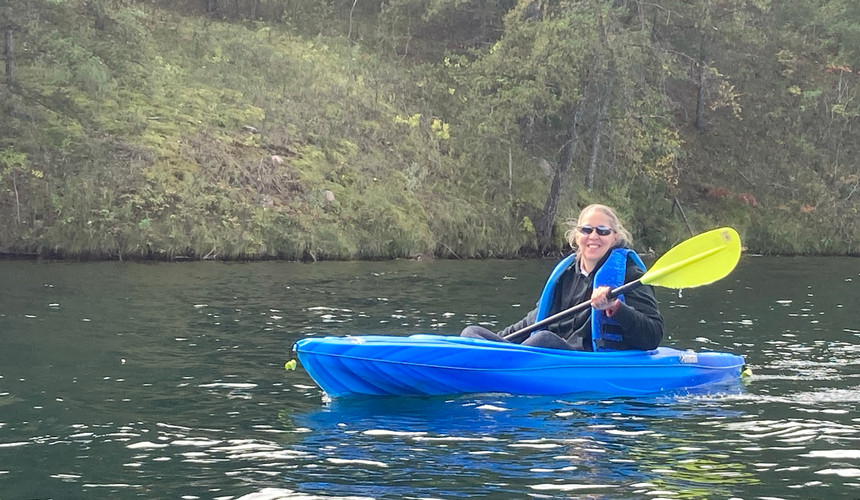
Cuyuna Recreation Area
Throughout our Minnesota travels, we have found some places that etch themselves into our memories more than others. Cuyuna Country State Recreation Area is just such a place. I have been visiting Cuyuna for close to ten years now and I get excited to return every time I head that direction. In this chapter of my life Heidi and I have visited the lakes and trails of the recreation area 3 times in less than a year and half. This is going to be the story of our adventures and the history of the area and what it took for it to be transformed from big holes in the ground to an incredible destination for hikers, bikers, kayakers, scuba divers, fisherman, campers, and history buffs.
I discovered Cuyuna about 8 years ago and have been heading there every summer since. I wanted to share this incredible place with Heidi and we first visited in the summer of 2021 and have been back up there a couple of times since. Cuyuna might be known for its mountain biking but it is also known for its water-filled mines. I have kayaked the pits about 10 times over the years and its beauty never ceases to amaze me . There is something special about paddling over the deep water of the pits and ghostly trees reaching up from the bottom like hands reaching for the surface. This makes the pits feel almost enchanted at times. Each time we head out paddling we plan a day around it. We will put in and paddle for about an hour and then take a break at one of the shallow areas. We will wade in the crystal clear water to cool off and have a snack and some water. After that we will explore the outer edges of the lakes looking for wildlife and remnants of the past. The kayaking is excellent and there aren't too many other people on the water. We will continue to paddle the rec area but we also discovered the beauty of the Cuyuna Lakes State Trail that runs 9.2 miles from the communities of Riverton to Deerwood. In the fall of 2022 we hiked a portion of the trail that runs through Cuyuna Country State Recreation Area. The fall colors were incredible and the trail has a quiet peacefulness to it. There are a couple really nice places to stop, take a break and take in the beautiful scenery. This place continues to amaze me and we are hoping to hike, bike and kayak more up there this coming summer.
After a day on the water or a long hike we love to stop off at Cuyuna Brewing Company in Crosby MN for a cold beverage. Throughout our adventures we have visited a bunch of different breweries and Cuyuna Brewing Company is one of our favorite stops. The brewery opened its doors in January of 2017 and has been bringing a large variety of beers to thirsty visitors ever since. The Brewery is located in a really cool old building located in the downtown area of Crosby. The brewery and beers pay homage to the history of the area, such as the Manhigh Stout. There is such a cool relaxed vibe in the taproom and we love to sit and look out the big windows. Cuyuna Brewing was the place where Heidi decided she liked stouts. I had ordered a stout and Heidi wasn’t really sure about the idea of drinking a stout. She must have looked undecided and the person behind the bar said she had to try their stout mixed with their in-house made root beer. She mixed up a sample for Heidi and Heidi was hooked. She now loves a good stout and it’s all thanks to the Cuyuna Brewing Company. The place is very family friendly and they embrace the outdoor lifestyle that the Cuyuna range has turned into. For more information about Cuyuna Brewing Company check out this great article by The Growler Magazine, https://growlermag.com/brewer-profile-nick-huisinga-cuyuna-brewing-company/
Just about a century before the idea of Cuyuna Country State Recreation Area was conceived it was a beautiful area full of forest and lakes with no signs of the red colored soil we know it for today. In 1895 a surveyor named Cuyler Adams and his faithful St. Bernard named Una discovered traces of magnetic ore while surveying land. The area was named Cuyuna by Adam’s wife. She took the first 3 letters of Cuyler’s name and the name of their St. Bernard Una and the name Cuyuna was created. Mining began on the Cuyuna Range in 1911 and continued until 1984. The iron ore deposits that were rich in manganese were located deep underground and shaft mining was employed at first to retrieve the ore. The need for steel during World War I and World War II created a high demand for the manganese rich ore to harden the steel in war time productions. During this time mining production peaked but after World War I many of the shaft mines closed and were replaced by open pit mines.
One of the shaft mines that survived after WWI was the Milford Mine, The Milford Mine was first opened in 1917 and had reached 200 feet in depth by and 2000 feet of horizontal shafts by 1924. The mine was owned by George H. Crosby and had shipped 70,000 tons of ore by its closing in 1931. The Milford Mine is not known for being one of the last shaft mines in the region or for the quantity of ore shipped. It is known for the unfortunate series of events that unfolded on February 5th 1924. At 3:45 pm on February 5th 1924, the waters of nearby Lake Foley broke through the walls of the mine. On that day there were 48 men working underground at the mine. When the water from the lake broke through the miners only had moments to scramble for the 135 foot ladder leading to the surface. Unfortunately only seven miners made it to the surface before the mine was completely filled with water and mud. 41 men died that day and it took 9 months to recover all of the bodies. It remains the worst mining disaster in Minnesota history. The mine closed in 1931 but the area has never forgotten the disaster and the men who lost their lives. In 2017 Milford Mine Memorial Park was opened in dedication to the men who lost their lives in the 1924 disaster. The park includes a picnic shelter, 450 foot boardwalk, interpretive trails, restrooms, and a miners memorial wall.
The Cuyuna range continued to produce ore through the early 1980’s but the mines are known for more than tragedy and its high quality iron ore. On august 18th 1957 the mines and the town of Crosby made national news for something that was out of this world. On August 18th at 11 pm Dr. David Simons climbed into a small capsule that was loaded on a flatbed truck in South St. Paul Minnesota. That truck and its precious cargo was heading to Crosby Minnesota and the Portsmouth Mine. The truck arrived at 5 am on the 19th and the capsule with Simons still inside was unloaded and prepped for take off. This was the beginning of an incredible adventure to collect information and data about what happens to the human body at the edge of space. This was the second of three biomedical research programs by the United States Air Force called Project MANHIGH. The MANHIGH II capsule was released from the Portsmouth mine to protect the 200 foot balloon from the wind as it was inflated. Dr. Simons set a new altitude world record of 101,516 feet during his 32 hour flight. He was the first person to see the sun rise and sun set from the edge of space. During his flight Simons collected valuable information, recorded scientific readings and took photographs that were later used by NASA. On August 20th at 5:32pm Dr Simons crawled from the capsule after it landed 10 miles northwest of Frederick, South Dakota. Simons was awarded the Distinguished Flying Cross, which was presented to him 24 August 1957. The photo he took of himself as he reached the peak altitude of the mission was on the cover of the September issue of Life Magazine.
Over the years the mines brought people to the area and they created communities around them but in the early 1980’s the last load of ore was hauled away and the mines closed down for good. According to the website https://www.cuyuna.com/history/ The next chapter of the Cuyuna range started about a year before the last load was shipped out. The creation of the Cuyuna Range Economic Development Incorporation was one first steps towards the creation of the Cuyuna Country Recreation Area. Soon after the mines closed and the area was left to its own devices the Cuyuna Country Mineland Reclamation Committee formed and with the help of the IRRRB, Crow Wing County and the Minnesota Department of Natural Resources the future of the area would be decided and plans put into motion. Steps were small at first but the decision was made to turn the area into a 5000 acre park. With the new idea of a park in hand the land started to be cleaned up and 30 pump trucks worth of trash were removed in the initial 4-hour cleanup. At first the DNR did not want anything to do with the new park being created and the Mineland Joint Powers Board (JPB) was tasked with managing the mining land until it formally became a state recreation area. Between the years of 1988 and 1993 the park was in limbo and the supporters of the park lobbied the state legislatures to pass the park bill into law and in 1993 the law was passed and Cuyuna Country State Recreation Area was the first recreation area managed by the Minnesota DNR. For more information about the rec area check out the Cuyuna Country State Recreation Area Minnesota DNR website:https://www.dnr.state.mn.us/state_parks/park.html?id=sra00302#homepage

The Cuyuna range has had an interesting history throughout which the people have been the center of the story. The area has gone through good and bad times and the people have held it together through them all. Cuyuna has become a mountain biking mecca in the midwest and has kept its humble roots. Heidi and I love the area and are always excited to visit. We are excited to see what the future holds there and will be posting about our adventures on instagram and on our website: https://www.where2minnesota.com/


























































Comments